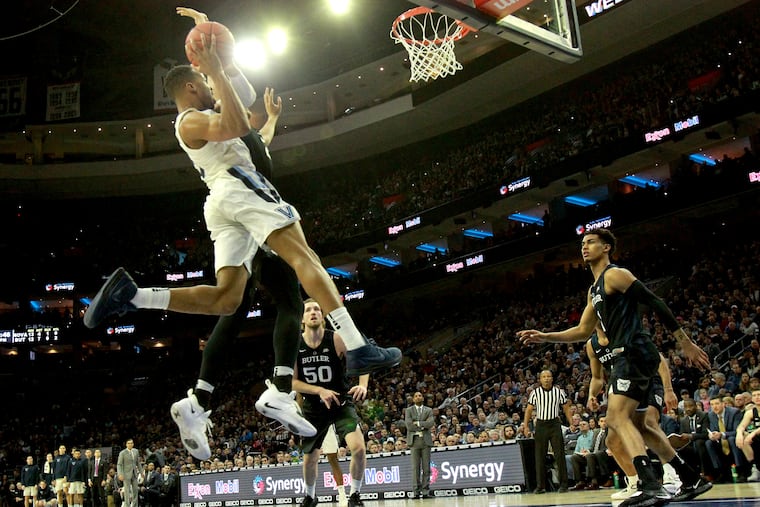An all-city team, and an insane decision by the Ivy League | City 6 observations
Villanova's Phil Booth and Eric Paschall and Temple's Shizz Alston hit the home stretch of a race for best player in the city.

City 6 observations, Vol. 16:
This is the last edition of City 6 observations for this season, so the right edition to choose an all-City 6 team.
The first team is remarkably obvious, the second team not so easy to determine, and the player of the year? … Still too soon to choose, although we’ll offer finalists.
Who are the no-brainer first-teamers? They all are. Eric Paschall and Phil Booth from Villanova, no-brainers. Shizz Alston from Temple, no-brainer. A.J. Brodeur from Penn. Charlie Brown from St. Joseph’s. No brainer, no brainer.
Let’s argue the first three are still in the hunt for player of the year, with Booth maybe an inch ahead of Paschall and Paschall maybe an inch in front of Alston. But choosing such a thing now is like when they force analysts to choose a player of the game on television when there are still four minutes left, the game undecided.
Any of those three could carry their teams to greater heights in March and make the player-of-the-year choice a ... well, no-brainer.
Statistically, there’s not a great deal separating Booth and Paschall, with Booth averaging 18.7 points and leading Villanova in assists and Paschall averaging 16.6 and leading Villanova in rebounding. Defensively, I’d give Paschall the edge. But Booth has made a few more late-game dagger shots, vitally important for Villanova this season, edging him in front.
Alston averages 19.9 points and leads Temple in assists, so he’s in the thick of this competition, and he has his own big-game heroics to match up.
If Penn had swept through the Ivy League as it had the Big Five, Brodeur might have been right in this mix, too. His numbers, 17.4 points and 8.4 rebounds, certainly stack up, both in the top five in the Ivies.
Brown is another one who can’t be considered for player of the year mainly because his team struggled so much, but he’s an obvious all-City 6 pick, averaging 19.2 points.
The second team gets dicier. Let’s start with a couple of La Salle guys. Pookie Powell is an easy choice, averaging 16.2 points, leading the Explorers as they overcame their 0-10 start to get to the middle of the Atlantic 10 pack. Saul Phiri is another choice since his return to play after first-semester academic issues exactly coincided with La Salle starting to win games.
Two Temple players also have to be on this list, with Nate Pierre-Louis and Quinton Rose being a big part of how the Owls got past 20 wins this season, however it plays out down the stretch.
That leaves one spot — and Fresh Kimble would have grabbed it, except for an injury that cost him 10 games late, right after St. Joe’s had lost four straight. We’ll give it to another Neumann-Goretti grad, Drexel’s Troy Harper, who really fought his way into a central role for the Dragons and led them in scoring at 15.8 ppg after a slow start to the season that included two scoreless outings in limited minutes in the first three games. In CAA play, Harper was up to 17 points a game.
If you want to argue that Kimble and Harper both belong on it, we’ll give it to you and put six players on, since it’s a City 6, which doesn’t even exist in any formal sense, which means we can do what we want here. We want both those guys on our team.
The Ivy League did what?
My view of the Ivy League’s decision to play its postseason tournament on every single campus, no matter how marginal its gym, before returning to the Palestra: It’s insane.
Actually, it’s worse than that. It’s a vote against caring about basketball at all.
Obviously, this decision was made by people who know all about what venues they are sentencing the Ivy tournament to play in. That makes it only more insane. So many of the league’s gyms are limited in capacity, devoid of character, lacking in amenities.
Seriously, Cornell and Dartmouth are hosting a league tournament? The league apparently couldn’t agree on smarter choices and decided to punt entirely, probably slapping itself on the back for standing up for fairness and balance.
Actual fairness would have put the league in a central location every year, in the middle of the league, even if it was off campus.
I’m not arguing to have it in the Palestra every year. Yes, that’s the best venue without any others even entering the conversation. But that would not be fair to have Penn hosting each year. I wrote that last year. But if you’re going to give everybody a shot at the tournament, maybe have the schools consider building an appropriate facility. They could afford it, if they cared enough about hoops.
Better, forget this idea of bringing the whole league together and let the top seeds host. There’s your fairness and balance. If Dartmouth ends up hosting, that’s completely fair since the team would have earned it and the fans would be excited about it. The Patriot League gets it right.
Unless I’m wrong. Unless every league should do this. Maybe the Atlantic 10 should scrap the Barclays Center and move around to all the venues. Start with Olean, move on to St. Louis next year. See how that goes. The Big Ten tournament could show up at Rutgers one year, Penn State another, Minnesota the next. It would be awesome.
Not a good idea? No, it’s an insane idea. Nobody would have even thought of it, except the Ivies.